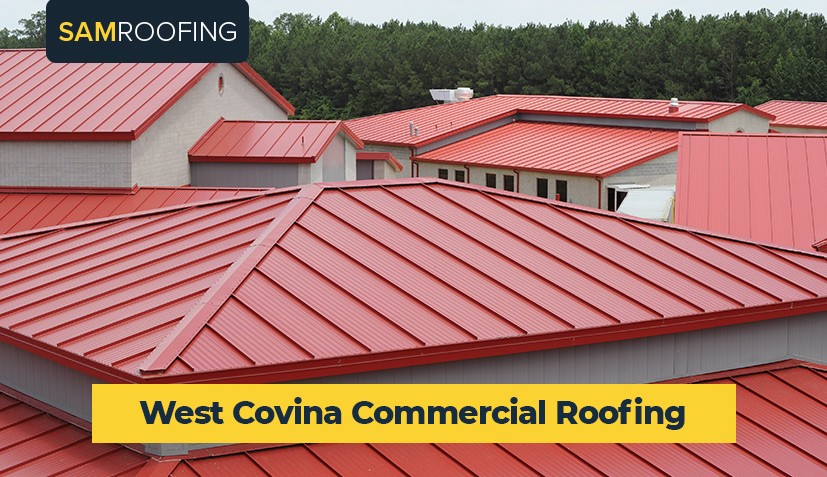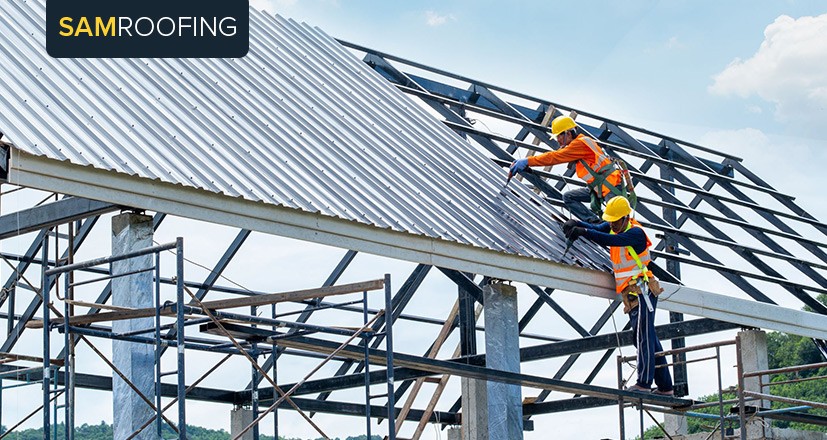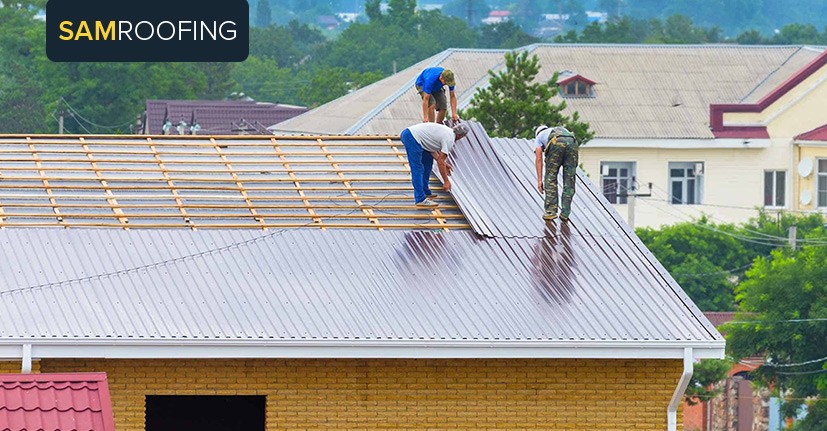West Covina Commercial Roofing
Sam Roofing is a dedicated West Covina commercial roofing service provider. Our goal is to provide your commercial property with a reliable roof that will last for many years.
 We have installed and maintained different commercial roofing systems, so we know the best ways to do roofing. We appreciate your business and promise that your roof will be well-constructed and withstand the weather. When you work with Sam Roofing, you know you’re dealing with a commercial roofing company that cares about your success.
We have installed and maintained different commercial roofing systems, so we know the best ways to do roofing. We appreciate your business and promise that your roof will be well-constructed and withstand the weather. When you work with Sam Roofing, you know you’re dealing with a commercial roofing company that cares about your success.
Types Of Commercial Roofs
Commercial roofs come in many types, sizes, and variations. Every industry has a roof type that is well suited to its needs. Below are three popular commercial roofing systems:
Thermoplastic Or PVC And TPO Roof Membrane
Roofs made of thermoplastic polyolefin (TPO) and polyvinyl chloride (PVC) are ideal for second-generation applications. They are highly reflective, thin, and resilient to bacterial development, UV rays, punctures, and most chemicals. Commercial roofs made of PVC or TPO are great for places like restaurants, hotels, and other businesses where the ventilation systems release oils.
Built-Up Roofing (Or BUR) Membrane
Also known as BUR roofing, built-up roofing is the typical tar and gravel roof system. When you’re looking for a low-slope roof system that is both strong and affordable, BUR is an excellent option.
Modified Bitumen Roofing
A modified bitumen commercial roofing system referred to as “mod-bit” roofing, comprises layers of bitumen and strengthened roof fabrics. This commercial roof is an excellent choice if you expect a lot of activity.
The Different Kinds of Materials Used in Commercial Roofing Projects
Here is a table showing different commercial roofing materials, the buildings they are ideal for, and the average cost per square foot:
| Built-Up Roofing (BUR) | Low-slope roofs, commercial buildings | $3.50 – $6.50 |
| Modified Bitumen Roofing | Low-slope roofs, commercial buildings | $4.50 – $7.50 |
| Thermoplastic Olefin (TPO) Roofing | Low-slope roofs, commercial buildings | $4.00 – $7.00 |
| Ethylene Propylene Diene Terpolymer (EPDM) Roofing | Low-slope roofs, commercial buildings | $3.50 – $6.50 |
| Metal Roofing | Low-slope and steep-slope roofs, industrial buildings | $5.50 – $12.00 |
| Spray Polyurethane Foam (SPF) Roofing | Low-slope roofs, commercial buildings | $4.00 – $7.00 |
| Green Roofing | Commercial and residential buildings with flat or low-slope roofs | $10.00 – $25.00 |
When Should I Replace Or Repair My Commercial Roof?
 Like most structures, your commercial roof is subject to wear and tear. Here are signs that your commercial roof needs repair:
Like most structures, your commercial roof is subject to wear and tear. Here are signs that your commercial roof needs repair:
Our Commercial Roofing Services In West Covina
Sam Roofing considers the building structure and classification, performance, and weather conditions when selecting a commercial roof suited to your roof function. Our services fall under these four categories:
Our Commercial Roofing Process
A lot goes into taking care of a commercial roof, no matter the type of service. All the inner workings can be summed up into these three steps, which stand between your problematic roof and an excellent solution.
Consultation: We value communication at Sam Roofing. We need to know the scope of your commercial roofing needs from your perspective before we can offer our professional advice. This is crucial if your roof installation requires an elaborate design or a complex build.
Inspection and estimation: A site visit will inform us of the extent of disrepair your commercial roofing has undergone. The building envelope encasing the interiors (structure, ceiling, insulation) and exteriors will be thoroughly examined against a commercial roof maintenance checklist. An exact estimate of costs will then be provided.
Building and handover: After the contract is signed, our team will start the roofing service that was agreed upon. We will work until the job is done according to a plan that includes careful clean-up. After your commercial roof is ready and you are satisfied, we will hand it over for sign-off.
Why Sam Roofing Is the Top Commercial Roofing Company In West Covina
 Be it a flat or sloped design, our roofing experts will protect your warehouse, restaurant, industrial complex, hospital, or multi-use structure. Below are a few of our core qualities:
Be it a flat or sloped design, our roofing experts will protect your warehouse, restaurant, industrial complex, hospital, or multi-use structure. Below are a few of our core qualities:
FAQ
What are the Different Permits Required for Commercial Roofing in West Covina?
The specific permits required for commercial roofing in West Covina, California can vary depending on the scope of the project and local regulations. However, some common permits that may be required for commercial roofing projects in West Covina include:
Building Permit: A building permit is required for any roofing work that involves structural changes, such as adding new roof supports or changing the roof slope.
Roofing Permit: A roofing permit is required for any roofing work that involves repairs, replacements, or new installations.
Electrical Permit: An electrical permit is required for any roofing work that involves electrical components, such as solar panels or rooftop HVAC units.
Plumbing Permit: A plumbing permit is required for any roofing work that involves changes to the building’s plumbing, such as rerouting drainage pipes.
Mechanical Permit: A mechanical permit is required for any roofing work that involves changes to the building’s mechanical systems, such as installing new ventilation fans or exhaust systems.
Can You Provide a Timeline for the Project?
The timeline for a commercial roofing project can vary depending on several factors, including the size and complexity of the project, the type of roofing material being used, and any weather or scheduling delays. Here is a general timeline for a typical commercial roofing project:
Pre-Project Planning: This stage involves assessing the needs of the building, developing a budget, and choosing a roofing material. This can take a few days to a few weeks depending on the scope of the project.
Permits and Approvals: The time required to obtain permits and approvals can vary depending on the local regulations, but typically takes a few weeks.
Roofing Material Delivery: The delivery time for roofing materials can vary depending on availability and location, but typically takes a few days to a few weeks.
Roof Removal: The old roofing material is removed from the building, which can take anywhere from a few days to a week, depending on the size and complexity of the roof.
Roof Installation: The new roofing material is installed, which can take anywhere from a few days to several weeks depending on the size and complexity of the roof.
Finishing and Cleanup: The roofing project is completed, including any necessary finishing work, and the site is cleaned up. This typically takes a few days to a week.
You will get a detailed timeline for the project at the beginning, which would give you a detailed estimate.
What are Some Maintenance Tips for Commercial Roofing?
Regular maintenance is crucial for ensuring the longevity and durability of a commercial roofing system. Here are some maintenance tips for commercial roofing:
Regular Inspections: Have a qualified roofing professional perform regular inspections to identify any potential issues before they become major problems.
Keep Gutters and Drains Clean: Clean gutters and drains regularly to prevent debris buildup and ensure proper water drainage.
Trim Trees: Trim any trees or branches that are close to the roof to prevent damage from falling branches or debris.
Check for Damage After Severe Weather: After severe weather, inspect the roof for any signs of damage, such as cracks, leaks, or missing shingles.
Address Issues Immediately: If any issues are identified during inspections or after severe weather, address them immediately to prevent further damage.
Keep the Roof Clean: Regularly clean the roof to prevent the buildup of debris, such as leaves, branches, and dirt.
Avoid Foot Traffic: Minimize foot traffic on the roof to prevent damage to the roofing material.
Maintain Proper Insulation: Proper insulation can help prevent heat loss and reduce the risk of ice dams and other issues.
Have a Maintenance Plan: Develop a comprehensive maintenance plan with a qualified roofing professional to ensure that the roof is properly maintained and any issues are addressed promptly.